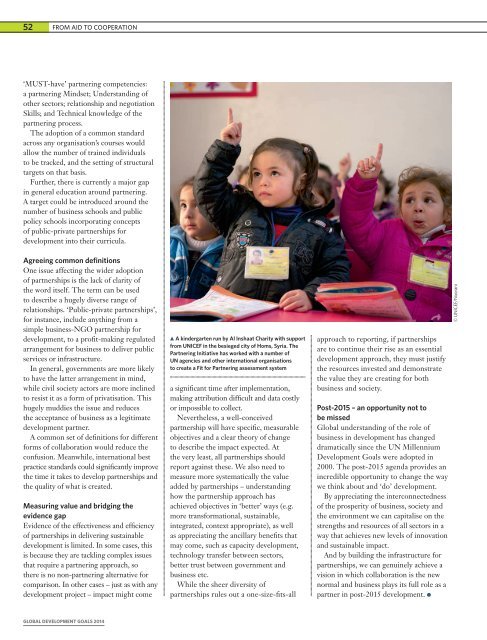FAMBB
FAMBB
FAMBB
You also want an ePaper? Increase the reach of your titles
YUMPU automatically turns print PDFs into web optimized ePapers that Google loves.
52 FROM AID TO COOPERATION‘MUST-have’ partnering competencies:a partnering Mindset; Understanding ofother sectors; relationship and negotiationSkills; and Technical knowledge of thepartnering process.The adoption of a common standardacross any organisation’s courses wouldallow the number of trained individualsto be tracked, and the setting of structuraltargets on that basis.Further, there is currently a major gapin general education around partnering.A target could be introduced around thenumber of business schools and publicpolicy schools incorporating conceptsof public-private partnerships fordevelopment into their curricula.Agreeing common definitionsOne issue affecting the wider adoptionof partnerships is the lack of clarity ofthe word itself. The term can be usedto describe a hugely diverse range ofrelationships. ‘Public-private partnerships’,for instance, include anything from asimple business-NGO partnership fordevelopment, to a profit-making regulatedarrangement for business to deliver publicservices or infrastructure.In general, governments are more likelyto have the latter arrangement in mind,while civil society actors are more inclinedto resist it as a form of privatisation. Thishugely muddies the issue and reducesthe acceptance of business as a legitimatedevelopment partner.A common set of definitions for differentforms of collaboration would reduce theconfusion. Meanwhile, international bestpractice standards could significantly improvethe time it takes to develop partnerships andthe quality of what is created.Measuring value and bridging theevidence gapEvidence of the effectiveness and efficiencyof partnerships in delivering sustainabledevelopment is limited. In some cases, thisis because they are tackling complex issuesthat require a partnering approach, sothere is no non-partnering alternative forcomparison. In other cases – just as with anydevelopment project – impact might comeA kindergarten run by Al Inshaat Charity with supportfrom UNICEF in the besieged city of Homs, Syria. ThePartnering Initiative has worked with a number ofUN agencies and other international organisationsto create a Fit for Partnering assessment systema significant time after implementation,making attribution difficult and data costlyor impossible to collect.Nevertheless, a well-conceivedpartnership will have specific, measurableobjectives and a clear theory of changeto describe the impact expected. Atthe very least, all partnerships shouldreport against these. We also need tomeasure more systematically the valueadded by partnerships – understandinghow the partnership approach hasachieved objectives in ‘better’ ways (e.g.more transformational, sustainable,integrated, context appropriate), as wellas appreciating the ancillary benefits thatmay come, such as capacity development,technology transfer between sectors,better trust between government andbusiness etc.While the sheer diversity ofpartnerships rules out a one-size-fits-allapproach to reporting, if partnershipsare to continue their rise as an essentialdevelopment approach, they must justifythe resources invested and demonstratethe value they are creating for bothbusiness and society.Post-2015 – an opportunity not tobe missedGlobal understanding of the role ofbusiness in development has changeddramatically since the UN MillenniumDevelopment Goals were adopted in2000. The post-2015 agenda provides anincredible opportunity to change the waywe think about and ‘do’ development.By appreciating the interconnectednessof the prosperity of business, society andthe environment we can capitalise on thestrengths and resources of all sectors in away that achieves new levels of innovationand sustainable impact.And by building the infrastructure forpartnerships, we can genuinely achieve avision in which collaboration is the newnormal and business plays its full role as apartner in post-2015 development.© UNICEF/NooraniGLOBAL DEVELOPMENT GOALS 2014


